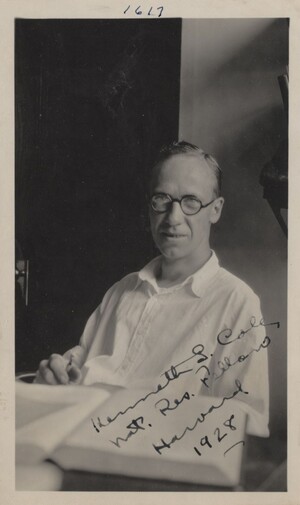Kenneth Cole spent his first summer at the MBL in 1924 working on the biophysics of the sea-urchin Arbacia’s eggs, and like many people who do work at the MBL, he never stopped coming back, and never stopped doing marine biology. Andrew Huxley, writing Cole’s memorial biography, said that Cole “became committed to biology” after this summer at the MBL. Cole’s education had been primarily in physics and electronics. For example, Cole was employed, while an undergraduate at Oberlin College, in Oberlin, Ohio, by General Electric to work at their research laboratory in Schenectady, New York. When he graduated from Oberlin, he went to Cornell University, in Ithaca, New York, to study physics (from 1922 to 1926). After his first year of graduate school Cole became interested in biology, and in merging biology and physics. In fact, today the Biophysical Society, headquartered in Rockville, Maryland, gives out an award named after Cole to “an investigator who has made a substantial contribution to the understanding of membrane biophysics” in honor of Cole’s pioneering work.
After the summer of 1936, at the encouragement of JZ Young, Cole brought his considerable biophysical acumen to bare on the problem of the squid giant axon and synapse. Cole’s technical background meant that he was able to constantly improve and refine his scientific equipment. He suggested improvements to a centrifuge microscope and built an apparatus that allowed him to make careful measurements of the elasticity and surface tension of the surface membrane of sea urchin eggs.
Then, in the summer of 1938, Cole introduced his methods, especially his preparation of the squid giant axon, to Alan Hodgkin who was visiting from Plymouth. Together they measured the resting state electrical resistance of the surface membrane of the squid giant nerve fiber. In 1939 Cole, and his frequent collaborator, Howard Curtis, refined the technology and technique sufficiently to be able to insert electrodes inside of the nerve fiber. Huxley, after Hodgkin came back from the MBL with these new methods, managed to do the same in Plymouth the same year, using slightly different methods. Even though the squid giant axon is giant, it is still fragile and relatively small on a human scale. It takes a considerable amount of expertise to prepare the axon and insert the microelectrode without damaging the nerve fiber.
- Biophysical Association. 2016. Kenneth S. Cole Award. http://www.biophysics.org.
- Boycott, Brian. 1998. "John Zachary Young. 18 March 1907-4 July 1997." Biographical Memoirs of Fellows of the Royal Society, November: 486-509.
- Cole, Kenneth. 1949. "Dynamic electrical characteristics of the squid axon membrane." Archives des Sciences Physiologiques 3: 253-258.
- Cole, Kenneth. 1965. "Electrodiffusion models for the membrane of squid giant axon." Physiological review 45: 340-379.
- Cole, Kenneth. 1941. "Rectification and inductance in the squid giant axon." Journal of General Physiology 25: 29-51.
- Cole, Kenneth, and H.J. Curtis. 1938. "Electric impedance of th4e squid giant axon during activity." Journal of General Physiology 22: 649-670.
- Gilbert, Daniel, William Adelman, and John Arnold. 1990. Squid as Experimental Animals. New York , NY: Plenum Press.
- Hodgekin, Alan, and B. Katz. 1949. "The effect of sodium ions on the electrical activity of the giant axon of the squid." Jouranl of physiology 108: 37-77.
- Hodgkin, Alan Lloyd. 1963. "The inoic basis of nervous conduction." Nobel Lecture.
- Hodgkin, Alan. 1963. "The ionic basis of nervous conduction." Nobel Lecture, December 11.
- Hodgkin, Alan, and Andrew Huxley. 1939. "Action potentionals recorded from insdide of a nerve fibre." Nature 144: 710-711.
- Hodgkin, Alan, and Andrew Huxley. 1947. "Potassium leakage from an active nerve fiber." Journal of Physiology 106: 341-367.
- Huxley, Andrew F. 1963. "The quantitative analyisis of excitation and conduction in nerve." Nobel Lecture.
- Huxley, Andrew. 2002. "From overshoot to voltage clamp." TRENDS in Neuroscience 25 (11): 553-558.
- —. 1996. "Kenneth Stewart Cole: July 10, 1900–April 18, 1984." National Academy of Sciences Biographical Memoir.
- —. 1963. "The quantitative analysis of excitation and conduction in nerve." Nobel Lecture, December 11.
- Keynes, Richard. 1999. "John Zachary Young (18 March 1907-4 July 1997)." Proceedings of the American Philosophical Society, December: 728-732.
- Nobelprize.org. 2016. "The Nobel Prize in Physiology or Medicine 1963." Nobel Media.
- Piccolino, Marco. 2002. "Fifty years of the Hodgekin-Huxley era." TRENDS in Neuroscience 25 (11).
- Schwiening, Christof J. 2012. "A brief historical perspective: Hodgkin and Huxley." Journal of Physiology 2571-2575.

